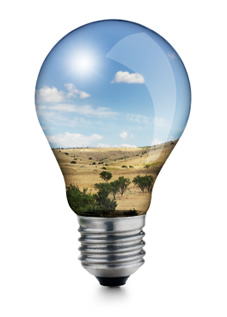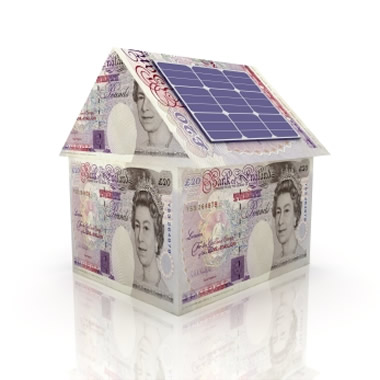Renewable Energy Solutions
 SA Tooley leads the way in using the latest and most reliable green energy technologies to provide cheap, environmentally friendly heating and hot water for your home or business.
SA Tooley leads the way in using the latest and most reliable green energy technologies to provide cheap, environmentally friendly heating and hot water for your home or business.
As well as adding value to your property, the high efficiency of these solutions means you can make savings whilst protecting the environment - lowering your property's carbon footprint.
Air Source Heat Pumps
Air source heat pumps absorb heat from the outside air. This heat can then be used to heat radiators, underfloor heating systems, or hot water in your home.
An air source heat pump extracts heat from the outside air in the same way that a fridge extracts heat from its inside. It can get heat from the air even when the temperature is as low as -15° C. Heat pumps have some impact on the environment as they need electricity to run, but the heat they extract from the ground, air, or water is constantly being renewed naturally.
Air source heat pumps (also known as ASHPs):
could lower your fuel bills, especially if you are replacing conventional electric heating
could provide you with an income through the government’s Renewable Heat Incentive (RHI)
could lower your home’s carbon emissions, depending on which fuel you are replacing
don't need fuel deliveries
can heat your home and provide and hot water
need little maintenance - they're called ‘fit and forget’ technology
can be easier to install than a ground source heat pump though efficiencies may be lower.
Unlike gas and oil boilers, heat pumps deliver heat at lower temperatures over much longer periods. During the winter they may need to be on constantly to heat your home efficiently. You will also notice that radiators won't feel as hot to the touch as they might do when you are using a gas or oil boiler.
Ground Source Heat Pumps
 Ground source heat pumps use pipes which are buried in the garden to extract heat from the ground. This heat can then be used to heat radiators, underfloor or warm air heating systems and hot water in your home.
Ground source heat pumps use pipes which are buried in the garden to extract heat from the ground. This heat can then be used to heat radiators, underfloor or warm air heating systems and hot water in your home.
A ground source heat pump circulates a mixture of water and antifreeze around a loop of pipe - called a ground loop - which is buried in your garden. Heat from the ground is absorbed into the fluid and then passes through a heat exchanger into the heat pump. The ground stays at a fairly constant temperature under the surface, so the heat pump can be used throughout the year - even in the middle of winter.
The length of the ground loop depends on the size of your home and the amount of heat you need. Longer loops can draw more heat from the ground, but need more space to be buried in. If space is limited, a vertical borehole can be drilled instead.
Ground source heat pumps (also known as GSHPs):
could lower your fuel bills, especially if you replace conventional electric heating
could provide you with an income through the government’s Renewable Heat Incentive (RHI)
could lower your home’s carbon emissions, depending on which fuel you are replacing
don't need fuel deliveries
can heat your home and provide hot water
need little maintenance - they're called ‘fit and forget’ technology.
Unlike gas and oil boilers, heat pumps deliver heat at lower temperatures over much longer periods. During the winter they may need to be on constantly to heat your home efficiently. You will also notice that radiators won't feel as hot to the touch as they might do when you are using a gas or oil boiler.
Solar Thermal
 Solar water heating systems use free heat from the sun to warm domestic hot water. A conventional boiler or immersion heater can be used to make the water hotter, or to provide hot water when solar energy is unavailable.
Solar water heating systems use free heat from the sun to warm domestic hot water. A conventional boiler or immersion heater can be used to make the water hotter, or to provide hot water when solar energy is unavailable.
The benefits of solar thermal:
Hot water throughout the year: the system works all year round, though you'll need to heat the water further with a boiler or immersion heater during the winter months.
Cut your bills: sunlight is free, so once you've paid for the initial installation your hot water costs will be reduced.
Cut your carbon footprint: solar hot water is a green, renewable heating system and can reduce your carbon dioxide emissions.
Rainwater Harvesting (new section)
Mains water is a precious resource due to increases in demand from our ever growing population. Changes in rainfall patterns in the UK have seen both drought conditions and flooding. Rainwater harvesting can provide around 50 per cent of a family’s water needs. This not only saves water, but saves money and reduces our impact on the environment.
A Precious Resource
It is highly likely that there will come a point where mains water supply will no longer be able to meet the needs of our growing population. This almost inevitable situation will have an environmental and financial impact on the infrastructure used by the water companies, which will be passed on to their customers.
This is why more and more people are capturing their own rainwater – to make sure they have enough for their needs at a price they can afford and at the same time minimise their impact on the environment.
How to Calculate the Number of Solar Panels I Need?
As a rule of thumb, 1m2 of net panel area is required per person per household, assuming that 50 litres of hot water is required per person per day. So for a household of 4 people the ideal would be to have 2 solar panels covering an area of 4m2.
As another rule of thumb 1 solar panel covering an area of 2m2 will support a hot water storage vessel of 150 litres.
3 solar panels covering an area of 6m2 will support a hot water storage vessel of 300 litres.
Greywater Recycling
Greywater is any household wastewater with the exception of wastewater from toilets, which is known as blackwater. Typically, 50-80% of household wastewater is greywater from kitchen sinks, dishwashers, bathroom sinks, tubs and showers.
 Freshly generated greywater is not as nasty as blackwater, but if it's not handled properly it can soon become so. Greywater decomposes at a much faster rate than blackwater and if stored for as little as 24 hours, the bacteria in it use up all the oxygen and the greywater becomes anaerobic and turns septic. After this point it is more like blackwater - stinky and a health hazard. In fact, many jurisdictions have strict regulations about disposal of greywater, some even require it to be treated as blackwater.
Freshly generated greywater is not as nasty as blackwater, but if it's not handled properly it can soon become so. Greywater decomposes at a much faster rate than blackwater and if stored for as little as 24 hours, the bacteria in it use up all the oxygen and the greywater becomes anaerobic and turns septic. After this point it is more like blackwater - stinky and a health hazard. In fact, many jurisdictions have strict regulations about disposal of greywater, some even require it to be treated as blackwater.
Not all greywater is equally "grey". Kitchen sink water laden with food solids and laundry water that has been used to wash toweling nappies are more heavily contaminated than greywater from showers and bathroom sinks. Although greywater from these sources contains less pathogens than blackwater, many regulatory bodies consider it as blackwater.
The safest way to handle greywater is to introduce it directly to the biologically active topsoil layer, where soil bacteria can quickly break it down, rendering the nutrients available to plants. This biological water purification is much more effective than any engineered treatment, thus protecting the quality of groundwater and surface waters.
Benefits of Greywater Recycling For Irrigation
Reduce fresh water use -. Capturing the indoor greywater for use outdoors can cut water usage considering.
Reduce strain on septic system or treatment plant - Greywater makes up the majority of the household wastewater stream, so diverting it from the septic system extends the life and capacity of the system. For municipal systems, decreased input means more effective treatment coupled with cost savings.
Groundwater Recharge - Greywater recycling for irrigation replenishes groundwater, helping the natural hydrologic cycle to keep functioning.
Plant growth - Greywater can support plant growth in areas that might otherwise not have enough water.
Maintain soil fertility - The nutrients in the greywater are broken down by bacteria in the soil and made available to plants. This helps to maintain soil fertility.
Enhance water quality - The quality of groundwater and surface waters are much better preserved by the natural purification processes the greywater undergoes in the top layers of the soil than by any engineered water treatment.
Greywater Irrigation May Not Be A Good Choice If:
Soil is not suitable - If your soil is either too permeable or not permeable enough, you may not be able to recycle your greywater, or you may need a system with some modifications.
Area too small - You need enough soil to process the greywater and enough plants to use it.

